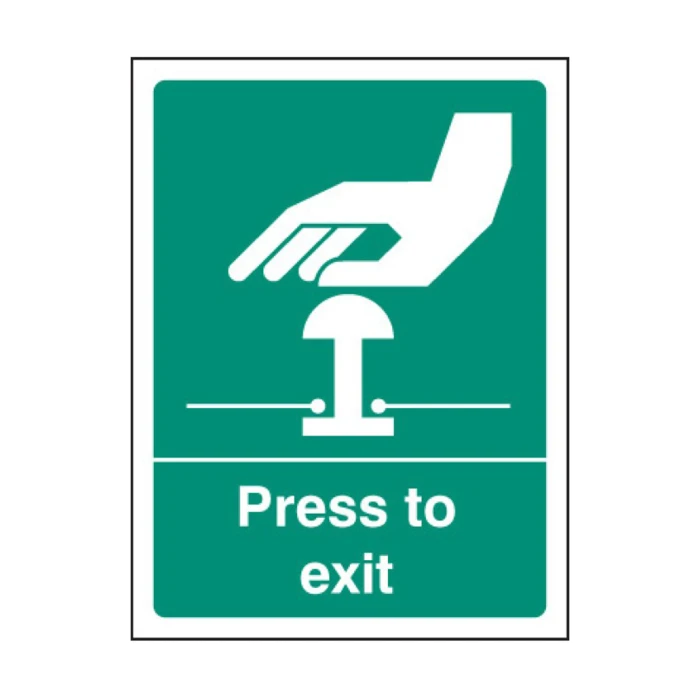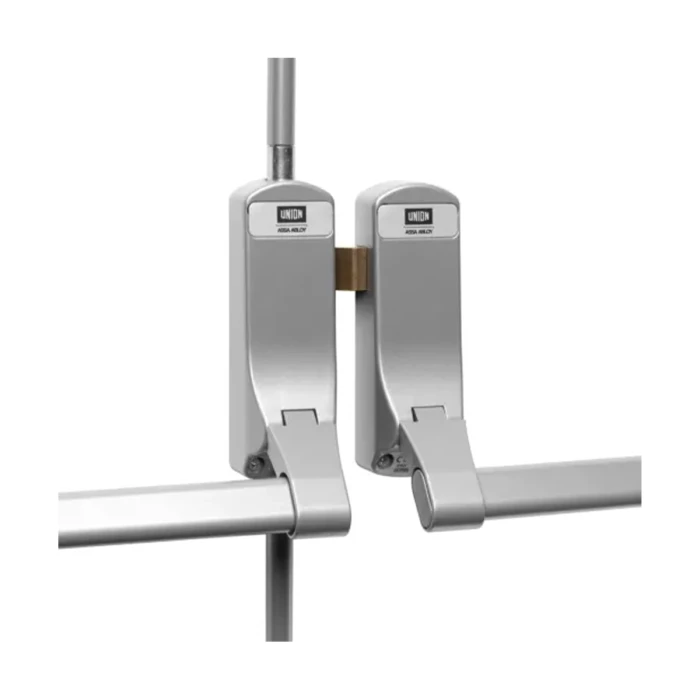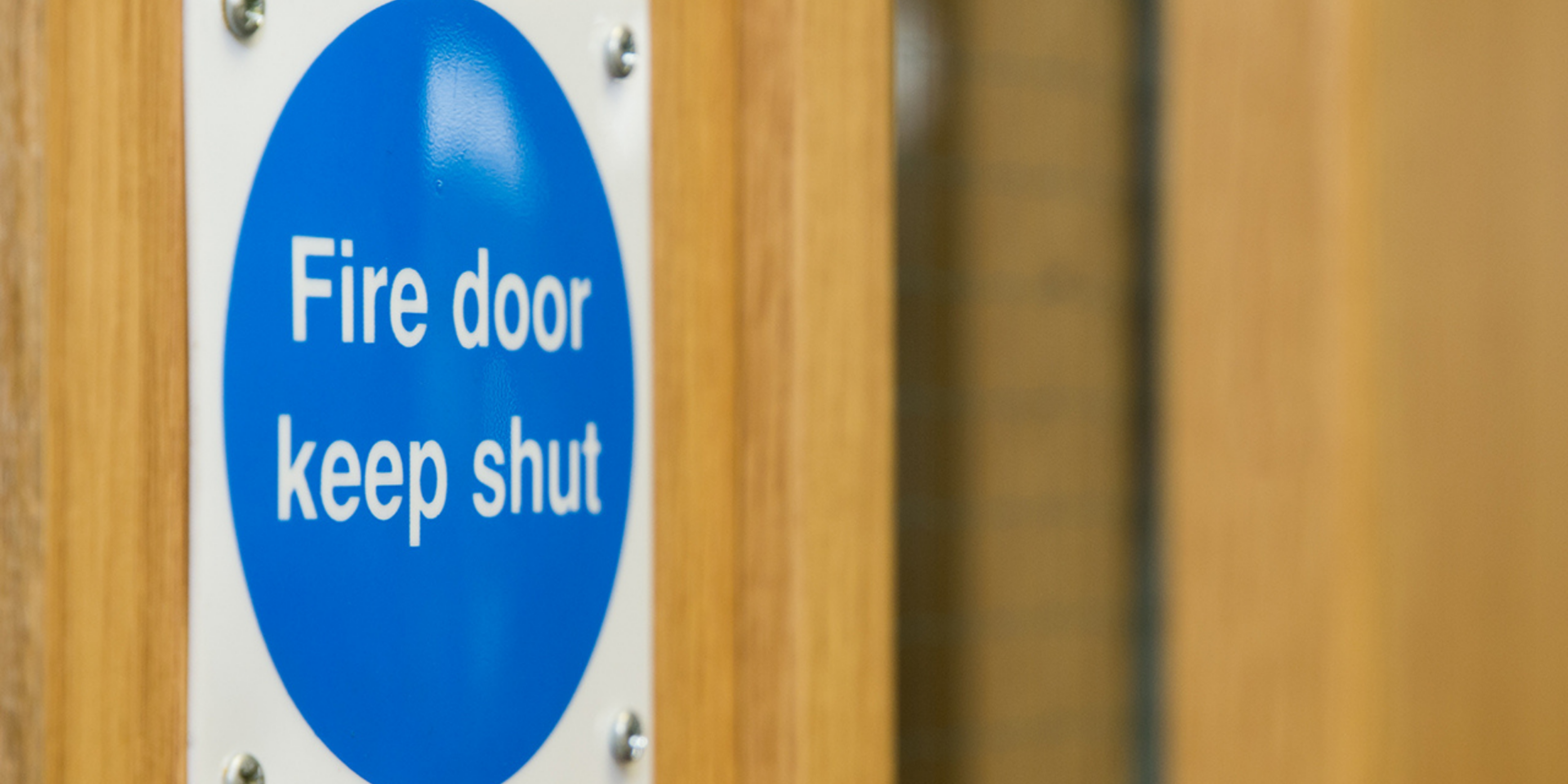
Need assistance?
Need Assistance? Call Us 0330 058 0631





















 Book a service
Book a service

05/06/2024 • by Lynsey B

Ensuring the safety of individuals within any building is a large responsibility and an important element of this is having proper emergency exits. This comprehensive guide covers everything you need to know about emergency exits, from the types of doors to regulations and maintenance. By understanding these essential elements, you can better protect yourself and others in case of an emergency.
A fire exit is a designated route for occupants to safely evacuate a building during a fire or other emergencies. Fire exits serve as essential elements of building safety. These exits are strategically positioned throughout buildings to ensure fast and efficient evacuation from any area. Typically, they consist of emergency exit doors that lead directly outside or to a safe location within the building.
The primary purpose of fire exits is to provide a clear and unobstructed path for people to escape from a building in the event of an emergency. They are marked with clear signage indicating their purpose, often featuring universally recognised symbols such as a running figure or an arrow pointing towards the exit.
The construction of fire exit doors is designed to facilitate a rapid exit. They are engineered to open easily and quickly, often featuring panic hardware or push bars for speedy opening. It is important that fire exit doors open in the direction of escape and remain unobstructed at all times to ensure a smooth evacuation process.
When it comes to ensuring quick and efficient egress during emergencies, the choice between panic bars and emergency pads for emergency exit doors is significant. When choosing between panic bars and emergency pads for emergency exit doors, several factors should be taken into account, including building occupancy, traffic flow and accessibility requirements. Additionally, compliance with relevant building codes and regulations is essential to ensure that the chosen mechanism meets safety standards and facilitates efficient evacuation in emergencies.

Panic bars, also referred to as crash bars, are horizontal bars typically installed on the inside of emergency exit doors. They are designed to be easily pressed by individuals evacuating a building in a state of panic or urgency. The mechanism behind panic bars is straightforward: when pressure is applied to the bar, it triggers the release of the door latch, allowing the door to swing open outward. This design is particularly advantageous in high-traffic areas where rapid evacuation is essential, as it allows occupants to exit without the need to manipulate locks or handles. The horizontal orientation of panic bars also makes them easily accessible to individuals of varying heights, including those with mobility impairments or disabilities.
Emergency pads, alternatively known as push pads, present a different approach. These pads are typically positioned at a convenient height on the door and require a firm push to activate the release mechanism. While similar in function to panic bars, emergency pads may necessitate a slightly stronger push and are generally less common in high-traffic environments. However, they offer an alternative option for buildings where specific design considerations dictate the use of push-pad mechanisms. Emergency pads may also be preferred in situations where a lower-profile exit device is desired, such as in areas with limited clearance or space constraints.
The responsibility for maintaining fire exits typically lies with the building owner or manager. It lies with the person who is legally obligated to ensure the safety of occupants and visitors within the premises. One of the primary responsibilities of building owners or managers is to ensure that emergency exit doors and routes remain unobstructed at all times. This includes keeping exit pathways clear of any obstacles, debris or equipment that could impede evacuation during an emergency. Additionally, it is essential to ensure that exit doors are easily accessible and can be opened without difficulty.
Regular inspections play a crucial role in maintaining fire exits. Building owners or managers should conduct routine checks to assess the condition of emergency exit doors, hinges, locks and panic hardware. Any signs of damage, wear and tear, or malfunction should be promptly addressed through repairs or replacements to ensure that the exits remain operational.
Furthermore, compliance with safety regulations is extremely important. Building owners or managers must adhere to relevant building codes and fire safety standards. This includes occupational health and safety regulations where fire exits must be maintained.
Fire exits must never be locked in a manner that prevents their immediate use during an emergency evacuation. The safety of building occupants relies on unimpeded access to these exits in situations such as fires or other emergencies. Locking or obstructing fire exits poses a significant risk, potentially trapping individuals inside the building and hindering their escape. It is worth noting that while fire exit doors should not be locked from the inside, they may have locking mechanisms on the exterior to prevent unauthorised entry. These mechanisms should be designed in such a way that they do not hinder anyone trying to leave during emergencies.

Determining the number of fire exits needed in a building is an important aspect of fire safety planning. The exact number and placement of these exits depend on various factors. Occupants need to be able to evacuate quickly and safely during an emergency.
The size and layout of a building are fundamental in deciding how many fire exits are necessary. Larger buildings naturally require more fire exits to accommodate the greater number of occupants and ensure that everyone can evacuate quickly. For example, a multi-storey office building will need more exits compared to a small retail shop. Complex layouts with long corridors, multiple rooms and varying levels increase the need for additional exits. Each section of the building should have accessible exits that prevent congestion and reduce evacuation time.
Occupancy is another huge factor. Different types of buildings have unique requirements. For instance, schools, hospitals and theatres often have higher occupancy levels and specific regulations to ensure the safe evacuation of children, patients or large crowds. The higher the number of people within a building, the more fire exits are needed to prevent bottlenecks during an evacuation. Regulatory standards often specify a maximum number of occupants per exit to ensure safety.

The specific use and function of the building also play a significant role in determining the number of fire exits required. Residential buildings might have different requirements compared to commercial buildings. For instance, a residential apartment complex will have specific exit needs tailored to sleeping occupants, whereas a commercial office building will consider working hours and occupant mobility. Buildings with specific uses, such as factories or warehouses, may need additional exits to account for hazardous materials or machinery that could stand in the way of a quick evacuation.
In the UK, regulatory building codes establish specific requirements for the number and placement of exits based on the type and size of the building. These codes are designed to uphold a minimum level of safety and are regularly revised to integrate the latest safety advancements. Alongside local regulations, national standards from organisations such as the British Standards Institution (BSI) provide comprehensive guidelines for fire safety.
UK building regulations outline precise criteria for the design and positioning of fire exits to ensure effective evacuation in emergencies. These standards are crucial in determining factors such as the width of exit routes, the types of doors and hardware permissible for fire exits, and accessibility considerations for all building occupants.
Furthermore, organisations like the Institution of Fire Engineers (IFE) contribute to the development of best practices in fire safety, offering additional guidance and expertise to enhance building resilience against fire hazards. By adhering to both local building codes and national standards, property owners and managers can significantly mitigate risks and ensure optimal safety measures are in place for all occupants.
Clear and visible signage is crucial for guiding occupants to safety during an emergency. Fire exit signs must be illuminated and placed strategically to indicate the nearest exit route. These signs should be visible from all areas of the building and lead directly to the emergency exit doors.
In the chaos and confusion of an emergency, clear emergency exit signage becomes a lifeline for occupants. Proper signage ensures that people can find their way to safety quickly and efficiently, even if they are unfamiliar with the building layout. Signs must be designed to be easily understood, even under stressful conditions. They must comply with specific regulatory standards that dictate their size, colour and illumination.

The strategic placement of fire exit signs is essential for effective evacuation. Signs should be positioned at key decision points along the escape route, including intersections, doorways and hallways. They should be placed at heights and locations where they are clearly visible, avoiding any obstructions that might block their view.
Fire exit signs must be visible under all conditions, including low light and smoke-filled environments. To achieve this, signs are often illuminated either by their own internal lighting or by external sources. In many buildings, emergency lighting systems are designed to ensure that signs remain visible even if the main power supply fails. These systems use backup batteries or generators to provide continuous illumination.
Regulatory standards dictate the specific requirements for fire exit signage to ensure consistency and effectiveness. These standards cover various aspects, including the design, placement and illumination of the signs. For instance, in the UK, fire exit signs must comply with the British Standards (BS 5499) and the Health and Safety (Safety Signs and Signals) Regulations 1996. These regulations specify the use of pictograms, text and directional arrows to clearly indicate escape routes.
Yes, emergency exit signs are required in all buildings, especially those accessible to the public. This includes commercial buildings, schools, hospitals and residential complexes. Proper signage is not only a legal requirement but also an important component of an effective evacuation plan.
The installation and maintenance of emergency exit lights in commercial buildings are essential safety measures mandated by the Health & Safety at Work Act. These lights are used for guiding occupants to safety during emergencies such as fires or power outages. Proper installation involves careful planning to ensure that lights are strategically placed along escape routes, stairways and exits. This process must comply with regulatory standards, such as the British Standards (BS 5266). Qualified fire safety professionals should handle the installation to ensure the lights are correctly integrated with the building's electrical system and backup power sources.
Once installed, emergency exit lights require regular testing and maintenance to ensure they function correctly when needed. Routine inspections should be conducted monthly to perform brief functional tests, ensuring the lights activate properly. Annually, a full-duration test should be carried out, typically for three hours, to verify the lights can sustain illumination for the required period. Maintenance involves checking and replacing batteries, which provide power during outages, and ensuring light bulbs are in good working condition. Regular maintenance not only ensures compliance with legal requirements but also guarantees the lights' reliability during an emergency.

Emergency lighting and regular lighting serve different purposes within a building. Understanding their distinctions is vital for ensuring safety during emergencies.
Regular lighting is designed for everyday use, providing illumination for various activities within a building. This type of lighting relies on the building's main power supply and is essential for normal operations, whether in homes, offices, schools or industrial settings. Regular lighting includes overhead lights, desk lamps and other fixtures used to create a comfortable and productive environment.
In contrast, emergency lighting is specifically designed to provide illumination during emergencies when the main power supply fails. Its primary function is to ensure that escape routes, such as corridors, stairways and exits, remain visible, allowing occupants to evacuate safely. Emergency lighting activates automatically when it detects a power outage or a fire alarm, providing continuous illumination for a specified duration. This can typically range from one to three hours.
Emergency lighting can be classified into several categories based on its specific function. For example, escape route lighting ensures that all escape routes are clearly illuminated, guiding occupants towards safety. Standby lighting provides illumination that allows normal activities to continue during a power failure. This is essential in environments like hospitals or data centres where operations must not be interrupted. Open area (anti-panic) lighting is put in place to reduce the risk of panic by illuminating large open areas and helping occupants locate escape routes.
We use cookies to enhance your site experience. Choose your preferences below.
